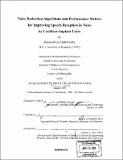| dc.contributor.advisor | Julie E. Greenberg. | en_US |
| dc.contributor.author | Goldsworthy, Raymond Lee, 1974- | en_US |
| dc.contributor.other | Harvard University--MIT Division of Health Sciences and Technology. | en_US |
| dc.date.accessioned | 2008-02-28T16:08:08Z | |
| dc.date.available | 2008-02-28T16:08:08Z | |
| dc.date.copyright | 2005 | en_US |
| dc.date.issued | 2005 | en_US |
| dc.identifier.uri | http://dspace.mit.edu/handle/1721.1/30268 | en_US |
| dc.identifier.uri | http://hdl.handle.net/1721.1/30268 | |
| dc.description | Thesis (Ph. D.)--Harvard University--MIT Division of Health Sciences and Technology, 2005. | en_US |
| dc.description | Includes bibliographical references (p. 229-233). | en_US |
| dc.description.abstract | This thesis addresses the design and evaluation of algorithms to improve speech reception for cochlear-implant (CI) users in adverse listening environments. We develop and assess performance metrics for use in the algorithm design process; such metrics make algorithm evaluation efficient, consistent, and subject independent. One promising performance metric is the Speech Transmission Index (STI), which is well correlated with speech reception by normal-hearing listeners for additive noise and reverberation. We expect the STI will effectively predict speech reception by CI users since typical CI sound-processing strategies, like the STI, rely on the envelope signals in frequency bands spanning the speech spectrum. However, STI-based metrics have proven unsatisfactory for assessing the effects of nonlinear operations on the intelligibility of processed speech. In this work we consider modifications to the STI that account for nonlinear operations commonly found in CI sound-processing and noise reduction algorithms. We consider a number of existing speech-based STI metrics and propose novel metrics applicable to nonlinear operations. A preliminary evaluation results in the selection of three candidate metrics for extensive evaluation. In four central experiments, we consider the effects of acoustic degradation, N-of-M processing, spectral subtraction, and binaural noise reduction on the intelligibility of CI-processed speech. We assess the ability of the candidate metrics to predict speech reception scores. | en_US |
| dc.description.abstract | (cont.) Subjects include CI users as well as normal-hearing subjects listening to a noise-vocoder simulation of CI sound-processing. Our results show that: 1) both spectral subtraction and binaural noise reduction improve the intelligibility of CI-processed speech and 2) of the candidate metrics, one method (the normalized correlation metric) consistently predicts the major trends in speech reception scores for all four experiments. | en_US |
| dc.description.statementofresponsibility | by Raymond Lee Goldsworthy. | en_US |
| dc.format.extent | 233 p. | en_US |
| dc.language.iso | eng | en_US |
| dc.publisher | Massachusetts Institute of Technology | en_US |
| dc.rights | M.I.T. theses are protected by copyright. They may be viewed from this source for any purpose, but reproduction or distribution in any format is prohibited without written permission. See provided URL for inquiries about permission. | en_US |
| dc.rights.uri | http://dspace.mit.edu/handle/1721.1/30268 | en_US |
| dc.rights.uri | http://dspace.mit.edu/handle/1721.1/7582 | |
| dc.subject | Harvard University--MIT Division of Health Sciences and Technology. | en_US |
| dc.title | Noise reduction algorithms and performance metrics for improving speech reception in noise by cochlear-implant users | en_US |
| dc.type | Thesis | en_US |
| dc.description.degree | Ph.D. | en_US |
| dc.contributor.department | Harvard University--MIT Division of Health Sciences and Technology | |
| dc.identifier.oclc | 60847548 | en_US |
